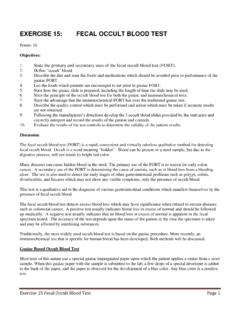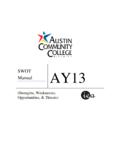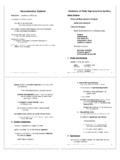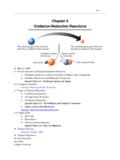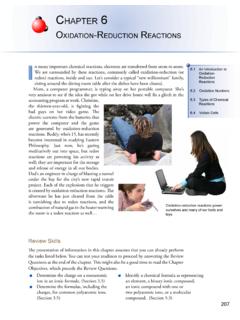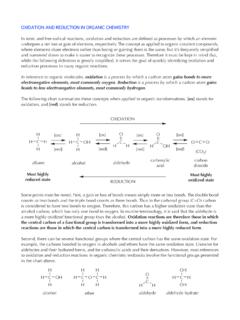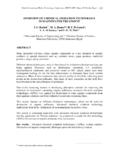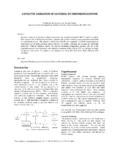Transcription of Example Exercise 17.1 Calculating Oxidation …
1 2011 Pearson Education, Chemistry: Concepts and Critical Thinking, 6th EditionCharles H. CorwinExample Exercise Oxidation Numbers for CarbonLet s begin by recalling that uncombined elements, as well as compounds, are electrically neutral. Thus, free elements and compounds have no charge.(a) In diamond, the Oxidation number of carbon is zero.(b) In dry ice, we assign oxygen an Oxidation number of 2. We can determine the Oxidation number of carbon in CO2as follows:(c) In marble, we assign calcium ion an Oxidation number of +2, and oxygen a value of 2. We can determine the value of carbon in CaCO3as follows:(d) In baking soda, we assign sodium ion an Oxidation number of +1, hydrogen a value of +1, and oxygen a value of 2. We can determine the Oxidation number of carbon in NaHCO3as follows:SolutionCalculate the Oxidation number for carbon in each of the following compounds:(a)diamond, C(b) dry ice, CO2(c) marble, CaCO3(d) baking soda, NaHCO3 2011 Pearson Education, Chemistry: Concepts and Critical Thinking, 6th EditionCharles H.
2 CorwinExample Exercise Oxidation Numbers for CarbonCalculate the Oxidation number for iodine in each of the following compounds:(a) iodine, I2(b) potassium iodide, KI(c) silver periodate, AgIO4(d) zinc iodate, Zn(IO3)2 Answers:(a) 0; (b) 1; (c) +7; (d) +5 Practice ExerciseCalculate the Oxidation number for nonmetal X in each of the following compounds:(a) X2(b) X2O(c) CaX2(d) HXO4 Answer:See Appendix ExerciseContinued 2011 Pearson Education, Chemistry: Concepts and Critical Thinking, 6th EditionCharles H. CorwinExample Exercise Oxidation Numbers for SulfurWe can begin by recalling that the charge on an ion corresponds to the sum of the Oxidation numbers.(a) In S2 , the Oxidation number of sulfur is 2.(b) In SO32 , the polyatomic anion has a charge of 2 . We assign oxygen an Oxidation number of 2 and write the equation(c) In SO42 , the polyatomic anion has a charge of 2.
3 We assign oxygen an Oxidation number of 2 and write the equation(d) In S2O32 , the polyatomic anion has a charge of 2 . We assign oxygen an Oxidation number of 2 and write the equationSolutionCalculate the Oxidation number for sulfur in each of the following ions.(a) sulfide ion, S2 (b) sulfite ion, SO32 (c) sulfate ion, SO42 (d) thiosulfate ion, S2O32 2011 Pearson Education, Chemistry: Concepts and Critical Thinking, 6th EditionCharles H. CorwinExample Exercise Oxidation Numbers for SulfurCalculate the Oxidation number for chlorine in each of the following ions:(a) hypochlorite ion, ClO (b) chlorite ion, ClO2 (c) chlorate ion, ClO3 (d) perchlorate ion, ClO4 Answers:(a) +1; (b) +3; (c) +5; (d) +7 Practice ExerciseCalculate the Oxidation number for nonmetal X in each of the following ions:(a) X (b) XO (c) XO2 (d) XO3 Answer:See Appendix ExerciseContinued 2011 Pearson Education, Chemistry: Concepts and Critical Thinking, 6th EditionCharles H.
4 CorwinExample Exercise Oxidizing and Reducing AgentsBy definition, the substance oxidized loses electrons, and its Oxidation number increases. The substance reduced gains electrons, and its Oxidation number decreases. After assigning Oxidation numbers to each atom, we have the following:The Oxidation number of hydrogen increases from 0 to +1. Thus, H2is oxidized. The Oxidation number of copper decreases from +2 to 0. Thus, the Cu in CuS is reduced. Note that the Oxidation number of S remains constant ( 2).The oxidizing agent is CuS because it causes hydrogen to be oxidized from 0 to +1. The reducing agent is H2because it causes copper to be reduced from +2 to Oxidation reduction reaction occurs when a stream of hydrogen gas is passed over hot copper(II) each of the following for the above redox reaction:(a) substance oxidized(b) substance reduced(c) oxidizing agent(d) reducing agent 2011 Pearson Education, Chemistry: Concepts and Critical Thinking, 6th EditionCharles H.
5 CorwinExample Exercise Oxidizing and Reducing AgentsA redox reaction occurs when molten aluminum reacts with iron(III) each of the following for the preceding redox reaction:(a) substance oxidized(b) substance reduced(c) oxidizing agent(d)reducing agentAnswers:(a) Al; (b) Fe2O3; (c) Fe2O3; (d) AlPractice ExerciseIdentify the oxidizing agent and reducing agent in the following redox reaction:Answer:See Appendix ExerciseContinued 2011 Pearson Education, Chemistry: Concepts and Critical Thinking, 6th EditionCharles H. CorwinExample Exercise Oxidizing and Reducing AgentsNotice that iodine solid is converted to iodide ion in an aqueous solution. Since I2gains electrons, it is reducedand I2is the oxidizing reducing agent is not as obvious. If we calculate the Oxidation number for sulfur in SO32 and SO42 , we find sulfur changes from +4 to +6 and loses electrons.
6 Thus, the sulfur in SO32 is oxidized, and SO32 is the reducing can illustrate the Oxidation and reduction processes for the redox reaction as follows:SolutionThe amount of iodine in a solution can be determined by a redox method using a sulfite solution:Indicate each of the following for the preceding reaction:(a) substance oxidized(b) substance reduced(c) oxidizing agent(d) reducing agent 2011 Pearson Education, Chemistry: Concepts and Critical Thinking, 6th EditionCharles H. CorwinExample Exercise Oxidizing and Reducing AgentsA redox reaction occurs when the tin(II) ion reacts with the iodate ion as follows:Indicate each of the following for the preceding redox reaction:(a) substance oxidized(b) substance reduced(c) oxidizing agent(d) reducing agentAnswers:(a) Sn2+; (b) IO3 ; (c) IO3 ; (d) Sn2+Practice ExerciseIdentify the oxidizing agent and reducing agent in the following redox reaction:Answer:See Appendix ExerciseContinued 2011 Pearson Education, Chemistry: Concepts and Critical Thinking, 6th EditionCharles H.
7 CorwinExample Exercise Redox Equations by Oxidation NumberIn this reaction, the Oxidation number of iron decreases from +3 in Fe2O3to 0 in Fe. Simultaneously, the Oxidation number of carbon increases from +2 to +4. Thus, each Fe gains three electrons, while each C loses two electrons. We can diagram the redox process as follows:Because the number of electrons gained and lost must be equal, we find the lowest common multiple. In this case, it is 6. Each Fe gains three electrons, so we place the coefficient 3 in front of CO and carbon atom loses two electrons, so we place the coefficient 2 in front of each iron atom. Because Fe2O3has two iron atoms, it does not require a , we verify that the equation is balanced. We check each element in the equation:Because all the elements are balanced, we have a balanced redox industrial blast furnace reduces iron ore, Fe2O3, to molten iron.
8 Balance the following redox equation using the Oxidation number method: 2011 Pearson Education, Chemistry: Concepts and Critical Thinking, 6th EditionCharles H. CorwinExample Exercise Redox Equations by Oxidation NumberBalance the following redox equation by the Oxidation number method:Answer:Practice ExerciseBalance the following redox reaction using the Oxidation number method:Answer:See Appendix ExerciseContinued 2011 Pearson Education, Chemistry: Concepts and Critical Thinking, 6th EditionCharles H. CorwinExample Exercise Redox Equations by Oxidation NumberIn this special Example , Cr2O72 and I2each contain a subscript that affects electron transfer. Note that there are two atoms of chromium in the reactant and two atoms of iodine in the product. Let s balance the chromium and iodine atoms this reaction, the Oxidation number of each iodine atom increases from 1 to 0, and the Oxidation number of each chromium atom decreases from +6 to +3.
9 We can show the loss and gain of electrons asThere are two chromium atoms, and so the total electron gain is six electrons. Thus, the total electron loss must also be six electrons. Because there are two iodine atoms, and only one iodide ion, we place the coefficients as follows:Next, we balance the oxygen and hydrogen atoms. Because there are 7 oxygen atoms as reactants, we place the coefficient 7 in front of H2O. This gives 14 hydrogen atoms, and so we place the coefficient 14 in front of H+.SolutionAqueous sodium iodide reacts with a potassium dichromate solution. Write a balanced equation for the following redox reaction: 2011 Pearson Education, Chemistry: Concepts and Critical Thinking, 6th EditionCharles H. CorwinExample Exercise Redox Equations by Oxidation NumberWe can verify that the equation is balanced by checking Last, we verify that the ionic charges are balanced.
10 On the left side of the equation, we have+14 6 2 = +6. On the right side of the equation, we have +6. Because the ionic charge on eachside is +6, the equation is a balanced equation for the following redox reaction:Answer:Practice ExerciseBalance the following redox reaction in an acidic solution using the Oxidation number method:Answer:See Appendix ExerciseContinued 2011 Pearson Education, Chemistry: Concepts and Critical Thinking, 6th EditionCharles H. CorwinExample Exercise Redox Equations byHalf-ReactionWe can balance the redox reaction by the half-reaction method as follows:Step 1:Because Fe2+is oxidized from +2 to +3, MnO4 must be reduced. The two half-reactions are as follows:Step 2:We can balance each half-reaction as follows:Step 3:Because Fe2+loses 1 e and MnO4 gains 5 e , we multiply the Fe2+half-reaction by 4:Then, we add the two half-reactions together and cancel the 5 e.
